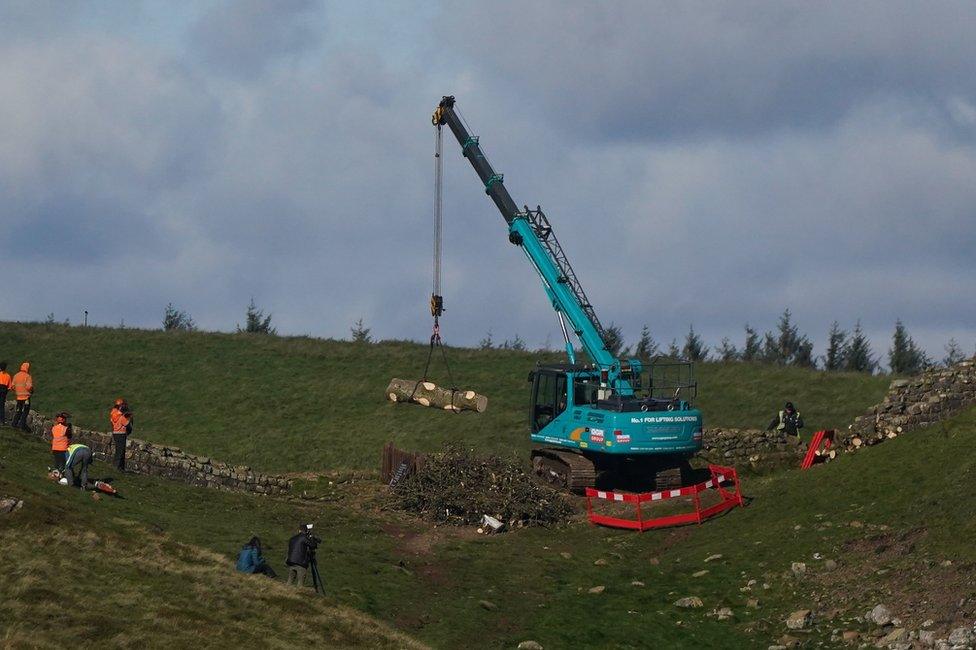Sycamore Gap: Cutting up Hadrian's Wall tree 'like a funeral'
- Published

The sections of the tree will be stored in an undisclosed location
The Sycamore Gap tree being cut up and removed from its site next to Hadrian's Wall was "like a funeral", a National Trust manager has said.
A crane was brought in to take the trunk away, which had to be cut into pieces as it weighed 3-4 tonnes.
Andrew Poad said it felt like "the funeral or the wake" of the 19th Century Northumberland tree, which he has worked around for about 35 years.
But he added: "This is where we can start talking about the future."
People were urged to stay away from the landmark while it was being removed.

A crane was brought in to remove the tree, which was cut into large pieces
Workers using chainsaws cut back its branches and the crane was moved into position to hoist it away.
Experts said they were aiming to keep the trunk in "as large sections as possible" to give them "flexibility" on its future.
The public has also been reassured that the tree's stump has been protected.

Tree surgeons have chopped up the sycamore so it can be removed
On Thursday a few walkers came through to see it but people seemed to be respecting the National Trust's request to keep away.
It was understood the sections of the felled tree would be moved from the site using a tractor and trailer later into the evening or on Friday morning.
The 50ft (15m) tree, which was made famous in the 1991 film Robin Hood: Prince of Thieves, will be taken to an unnamed National Trust property where it will be "safely stored".
Part of Hadrian's Wall was also damaged when the tree came down, some time between the evening of 27 September and morning of 28 September.

The tree was planted in the late 1800s by a previous land owner
"It's been a huge challenge, but it's been a real collaborative effort by the partners on Hadrian's Wall," said Mr Poad, general manager of the site.
"We've explored all the options but we believe we've come up with the safest plan for the people who are going to be doing the work and importantly for the wall itself, the last thing we want to do is cause any more damage to the monument by removing the tree.
He said they did not want to "restrict our options for the future" so it would be kept in "as large pieces as we possibly can".
Options include turning the tree into benches or sculptures, but specialists are maintaining an "open mind" as to what to do with it following thousands of suggestions from the public.
Watch: Emotional scenes as tree chopped up and removed

The famous landscape has changed forever
He said they would then speak to "partners and the local community and the public and come up with a way of memorialising the tree longer term".
The tree, which was seen as a symbol of Northumberland, and was a popular site for photographers and walkers due to its location in a dramatic dip in the land, was planted by previous landowner John Clayton in the late 1800s.
Mr Clayton was a keen excavator of Hadrian's Wall and was thought to have planted the tree to fill the dip on the landscape which was created by glacial meltwater.

Workers stand near a log, as sections of the Sycamore Gap tree are removed
Mr Poad called its final journey "a turning point" in the history of the site.
"It's quite remarkable for us working here, we do feel like we've lost a family member, it's had its Hollywood career back in the '90s, but with the advent of social media it's really taken on a life of its own," he said.
"When it won tree of the year a few years ago that gave it a notoriety, and it's been really apparent that it's touched an awful lot of people all over the world."

The stump, which could generate new shoots, will be left, and seeds have been collected which the National Trust said could be used to propagate saplings.
A Northumbria Police investigation continues and a 16-year-old boy and a man aged in his 60s arrested on suspicion of criminal damage remain on bail.

Follow BBC North East & Cumbria on X (formerly Twitter), external, Facebook, external and Instagram, external. Send your story ideas to northeastandcumbria@bbc.co.uk, external.
Related topics
- Published11 October 2023

- Published8 October 2023

- Published28 September 2023

